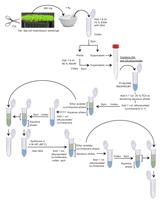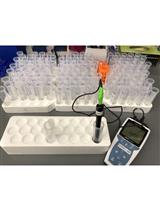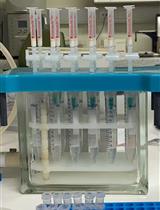- EN - English
- CN - 中文
Evaluation of Root pH Change Through Gel Containing pH-sensitive Indicator Bromocresol Purple
通过含有pH敏感指示剂溴甲酚紫的凝胶评估根部pH值的变化
发布: 2018年04月05日第8卷第7期 DOI: 10.21769/BioProtoc.2796 浏览次数: 9306
评审: Arsalan DaudiLaia ArmengotVinay Panwar
Abstract
The Rapid Alkalinization Factor (RALF) is a plant hormone peptide that inhibits proton transport causing alkalinization of the extracellular media. To detect the alkalinization response elicited by RALF peptides in root cells, Arabidopsis seedlings are carefully transferred to a gel containing the pH-sensitive indicator bromocresol purple, treated with the peptide and photographed after 30 min. Herein the protocol is optimized for evaluation of exogenous treatment, described in detail and expected results are presented.
Keywords: pH indicator (pH指示剂)Background
Proton transport is induced by a myriad of signals and is used by plants to coordinate growth, defense and development. Some plant hormone peptides can affect proton transport, causing a strong alkalinization of the extracellular medium (Felix and Boller, 1995; Pearce et al., 2001a). The 5 kDa peptide hormone Rapid Alkalinization Factor (RALF), after being secreted, binds to its receptor FERONIA, and causes the phosphorylation of the plasma membrane H+-Adenosine triphosphatase 2, inhibiting proton transport and alkalinizing the extracellular media (Pearce et al., 2001b; Haruta et al., 2014).
Growth media containing the pH indicator bromocresol purple is an effective method to visualize alkalinization or acidification in the media around the roots. This method has been used previously to show that NaRALF is required for regulating root hair extracellular pH (Wu et al., 2007), and that roots of plants overexpressing AtRALF23 have reduced capacity to acidify the rhizosphere (Srivastava et al., 2009). Growth medium with the pH indicator bromocresol purple was also used by Masachis et al. (2016) to demonstrate that RALF homologs produced by fungal pathogens induced alkalinization of media around the roots of tomato plants.
We have optimized the pH indicator bromocresol purple protocol and using the improved protocol we were able to visualize the alkalinization effect around Arabidopsis roots after AtRALF1 treatment in wild type and mutant seedlings (Dressano et al., 2017). Here we demonstrate how this assay can provide qualitative information on the extracellular pH that surrounds Arabidopsis roots.
Materials and Reagents
- Biological material
- Arabidopsis thaliana seeds and seedlings (Ecotype Columbia, Col-0)
- In-house produced 6xHis AtRALF1 recombinant peptide
- Arabidopsis thaliana seeds and seedlings (Ecotype Columbia, Col-0)
- Chemicals and materials for seed sterilization and growth
- Square Petri dish with Grid 100 mm W x 15 mm H, sterile (Electron Microscopy Sciences, catalog number: 70691 )
- Clear plastic wrap
- Graduated cylinder 1,000, 100 and 10 ml (Uniglas)
- 1,000 µl filter tips (NEST Scientific, catalog number: NPT1000-B-B )
- 200 µl filter tips (NEST Scientific, catalog number: NPT0200-B-Y )
- 10 µl filter tips (NEST Scientific, catalog number: 301001 )
- Gellan Gum Powder (Culture Gel TM Type I- BioTech Grade) (PhytoTechnology Laboratories, catalog number: G434 )
- Murashige & Skoog Basal Salt Mixture (PhytoTechnology Laboratories, catalog number: M524 )
- Sterile distilled water
- Sodium hypochlorite solution
- Sodium hypochlorite (NaClO) solution 50% (v/v) (see Recipes)
- Square Petri dish with Grid 100 mm W x 15 mm H, sterile (Electron Microscopy Sciences, catalog number: 70691 )
- Chemicals and materials for gel containing the pH-sensitive indicator bromocresol purple
- Graduated cylinder 100 ml (Uniglas)
- Petri dish 150 x 20 mm sterile
- Bromocresol purple free acid reagent Grade (C2H16Br2O5S, AMRESCO, catalog number: 0531-25G )
- Calcium sulfate dihydrate (CaSO4·2H2O, Merck, catalog number: 102161 )
- Potassium hydroxide (KOH)
- Hydrochloric acid (HCl)
- Agarose RA (Biotechnology Grade, AMRESCO, catalog number: N605-500G )
- Sterile distilled water
- Graduated cylinder 100 ml (Uniglas)
Equipment
- Weighing balance (RADWAG Wagi Elektroniczne, model: AS 220/C/2 )
- Magnetic stirrer (Fisher Scientific)
- pH meter (Thermo Orion, PerpHecT LongR meter, model: 350 )
- Pipettes (Nichipet EX, P1000, P200, P10)
- Beaker 1,000 ml (PHOX, Boro 3.3)
- Beaker 250 ml (APRX, Boro 3.3)
- Autoclave (Sercon, model: HS 1-0101 )
- Laminar flow hood (Pachane, model: PA 440 )
- Growth chamber/Controlled environment room
- Erlenmeyer (PIREX)
- Microwave (BRASTEMP, catalog number: BMJ38ARANA )
- Tweezers
- Digital camera (Cyber-shot, Sony, model: DSC-H300 )
Procedure
文章信息
版权信息
© 2018 The Authors; exclusive licensee Bio-protocol LLC.
如何引用
Silva, A. L., Dressano, K., Ceciliato, P. H. O., Guerrero-Abad, J. C. and Moura, D. S. (2018). Evaluation of Root pH Change Through Gel Containing pH-sensitive Indicator Bromocresol Purple. Bio-protocol 8(7): e2796. DOI: 10.21769/BioProtoc.2796.
分类
植物科学 > 植物生物化学 > 植物激素
植物科学 > 植物生理学 > 离子分析
生物化学 > 其它化合物 > 离子
您对这篇实验方法有问题吗?
在此处发布您的问题,我们将邀请本文作者来回答。同时,我们会将您的问题发布到Bio-protocol Exchange,以便寻求社区成员的帮助。
提问指南
+ 问题描述
写下详细的问题描述,包括所有有助于他人回答您问题的信息(例如实验过程、条件和相关图像等)。
Share
Bluesky
X
Copy link















